At first I like to share you some information about loading sequences of the percussion (or muzzle-loaded cap and ball) revolvers, because I think it is a less-known topic.
The loading sequence and basic operation of the Colt revolvers remained constant throughout the percussion period, and mirrors the operation of most other percussion revolvers. A shooter familiar with the basic operation of the Colt would find the function of a Remington, LeMat, Adams, or Cooper double action essentially identical.
Percussion revolvers are carried with the hammer down between chambers, with a groove or protuberance in the hammer engaging either a safety peg or notch in the rear of the cylinder. This method prevents inadvertent rotation of the cylinder, and prevents the hammer from touching the percussion caps and firing the weapon unintentionally. Patersons and a few later revolvers such as the Rogers and Spencer lacked these safety detents, requiring that they be carried with the hammer down on an empty chamber.
To load:
- Draw the hammer back to the first detent, placing it on “half cock” and allowing the cylinder to rotate for loading;
- Fill the chambers with powder, leaving enough room to seat a bullet or ball, and place a ball on the chamber mouth with the sprue (mark or projection left from filling the mould) facing exactly forward;
- Rotate the chamber under the rammer and use the loading lever (if present) to seat the projectile firmly on top of the powder column and at or below the chamber mouth;
- Place percussion caps on each of the nipples at the rear of the chambers;
- Rotate the cylinder as necessary and return the hammer to down position (pull it back slightly, squeeze trigger and let hammer down carefully) engaging the safety detents; or
- Draw the hammer back to full cock for immediate firing.
What is the SA (single action) revolver?
A single-action revolver is thumb-cocked before firing, which rotates the cylinder and puts a loaded chamber under the hammer; the trigger then is pulled to fire. With double-action revolvers, a single long pull on the trigger cocks the hammer, rotates the cylinder and fires the arm.
After it lets see the evolution of the Colt SA revolvers.
1847 Colt Walker .44
The Colt Walker is a single action (SA) revolver with a revolving cylinder holding six charges of black powder behind six bullets. It was designed in 1846 as a collaboration between Captain Samuel Hamilton Walker and American firearms inventor Samuel Colt.
The Colt Walker was the largest and most powerful black powder repeating handgun ever made. (Length: 15,5 inches; Weight: 4,5 lb (2,06 kg)) The Colt Walker holds a powder charge of 60 grains (3.9 g) in each chamber, more than twice what a typical black powder revolver holds. It weighs 4½ pounds (2 kg) unloaded, has a 9-inch (229 mm) barrel, and fires a .44 caliber (0.454 in, 11.53 mm diameter) conical and round ball.
Only 1100 of these guns were originally made, which makes originals extremely difficult and expensive to obtain.
Clint Eastwood used this type of revolvers in the the outlaw josey wales movie.
1848 Colt Dragoon .44
The Colt Model 1848 Percussion Army Revolver is a .44 caliber revolver designed by Samuel Colt for the U.S. Army’s Mounted Rifles, also known as “Dragoons”. This revolver was designed as a solution to numerous problems encountered with the Walker Colt: the Walker’s large size, four and a half pounds, making it suitable only for use as a saddle-mounted revolver, the Walker’s propensity for cylinders exploding on occasion when fired (due to the chambers being loaded with too much powder), and the Walker’s habit of dropping the loading lever upon discharge, locking up the revolver action in the middle of combat. The Colt Dragoon Revolver had a comparatively shorter cylinder (thus preventing overloading the cylinder) and held up to 50 grains of powder, whereas the Walker had used up to 60 grains of powder. The Dragoon Revolver had a shorter barrel at 7.5 inches (some later revolvers 8 inches) as compared to the 9 inches (230 mm) barrel on the Walker.
Although it was introduced after the Mexican-American War, it became popular among civilians during the 1850s and ’60s, and was also used during the American Civil War.
The Colt Dragoon Revolver was produced with several variations between 1848 and 1860, when the Colt Model 1860 revolver replaced it. All the improvements in design of Colt revolvers were applied to the Dragoons as well to the smaller models of Colt revolvers.
Total production of Colt Dragoons from 1847 to 1860 are 18,700; plus 750 Dragoons in a separate number range for the British market.
Hailee Steinfeld use it as Mattie Ross in True Grit movie.
1851 Colt Navy .36
The Colt Revolving Belt Pistol of Naval Caliber (i.e., .36 cal), later known as the Colt 1851 Navy or Navy Revolver, is a cap and ball revolver. It was designed by Samuel Colt between 1847 and 1850. It remained in production until 1873, when revolvers using fixed metallic cartridges came into widespread use.
The designation “Colt 1851 Navy” was applied by collectors, though the popular name “Navy Revolver” is of early origin, as the gun was frequently called the “Colt Revolving Belt Pistol of Naval Caliber”.
Famous “Navy” users included Wild Bill Hickok, John Henry “Doc” Holliday, Richard Francis Burton, Ned Kelly, and Robert E. Lee. Usage continued long after more modern cartridge revolvers were introduced in 1873.
The .36 caliber Navy revolver was much lighter (1,2-1,3 kg) than the contemporary Third Model Dragoon revolvers developed from the .44 Walker Colt revolvers of 1847, which, given their size and weight, were generally carried in saddle holsters.
The .36 caliber (.375–.380 inch) round lead ball weighs 86 grains and, at a velocity of 1,000 feet per second, is comparable to the modern .380 pistol cartridge in power. Loads consist of loose powder and ball or bullet, metallic foil cartridges (early), and combustible paper cartridges (Civil War era), all combinations being ignited by a fulminate percussion cap applied to the nipples at the rear of the chamber.
Total production of Colt 1851 Navy from 1850 to 1873 are 250.000.
1860 Colt Army .44
The Colt Army Model 1860 is a muzzle-loaded cap & ball .44-caliber revolver used during the American Civil War, made by Colt’s Manufacturing Company. It was used as a side arm by cavalry, infantry, artillery troops, and naval forces.
The Colt 1860 Army uses the same size frame as the .36 caliber 1851 Navy revolver. The frame is relieved to allow the use of a rebated cylinder that enables the Army to be chambered in .44 caliber. Also, the barrel on the 1860 Army has a forcing cone that is visibly shorter than that of the 1851 Navy, allowing the Army revolver to have a longer cylinder.
More than 200,000 were manufactured from 1860 through 1873. Colt’s biggest customer was the US Government with over 127,000 units being purchased and issued to the troops.
The Colt .44-caliber “Army” Model was one of the most widely-used revolvers of the Civil War.
There are very few variations on the 1860 Army Revolver, but there was limited production of a 7.5-inch barrel model.(Wilson 1985), and a lightened model with cylinder flutes. According to importer Cimarron Arms Company, this was called the “Texas Model” because a number of them came into Texas shortly after secession. The goal was to make use of silver spring steel of controlled carbon content and greater strength, but the thinned cylinder proved inadequate and sometimes exploded.
1873 Colt .45LC
The Colt Single Action Army (also known as the Model P, Peacemaker, M1873, Single Action Army, SAA, and Colt 45) is a single action revolver with a revolving cylinder holding six metallic cartridges. It was designed for the U.S. government service revolver trials of 1873 by Colt’s Patent Firearms Manufacturing Company, today Colt’s Manufacturing Company, and adopted as the standard military service revolver until 1892.
The Colt Single Action Army has been offered in over 30 different calibers and various barrel lengths. Its overall appearance has remained consistent since 1873. Colt has discontinued its production twice, but brought it back due to popular demand. The revolver was popular with ranchers, lawmen, and outlaws alike.
The .45 Colt cartridge was of center fire design containing charges of up to 40 grains (2.6 g) of fine grained black powder and a 255-grain (16.5 g) blunt round nosed bullet. Relative to period cartridges and most later handgun rounds, it was quite powerful in its full loading.
The Single Action Army action is a refinement of the earlier Colt percussion revolvers.
The cylinder is mounted on a central axis and operated by a hand with a double finger whose more extended action allowed the cylinder-ratchet to be cut in a larger circle, giving more torsional force to the cylinder. Three notches on the face of the hammer engage the sear portion of the trigger, affording four basic hammer positions. The hammer when fully lowered rests within the frame. Drawn slightly to the rear, the hammer engages the safety notch of the sear and holds the firing pin out of direct contact with a chambered cartridge. Like the earlier percussion revolvers, the Single Action Army was designed to allow loading of all of the chambers. The safety notch replaced pins on the rear of the percussion revolver cylinders which served the same purpose as the safety position by preventing hammer contact with the primer/percussion cap. However, many users adopted the practice of leaving one empty chamber under the hammer because a sharp blow could damage the mechanism and allow the fully loaded revolver to fire. This practice is now universally recommended.Drawn back about half way, the hammer engages the second notch. This cams the cylinder bolt out of engagement and allows the cylinder to rotate for loading. Fully cocked, the revolver is ready to fire. Cartridge ejection is via the spring-loaded rod housed in a tube on the right side of the barrel.
The loading sequence is as follows:
- Place the revolver on half-cock and open the loading gate to the side.
- Load each chamber in sequence (original), setting the hammer in the safety notch when finished; or (safe and prudent method) load one chamber, skip the next, load the remaining four chambers, close the loading gate, draw the hammer to full cock and lower fully, making sure that the firing pin is over the empty chamber.
- Firing the revolver is accomplished by drawing the hammer to full cock and pulling the trigger. The hammer must be manually cocked for each shot.
Page by SAPE
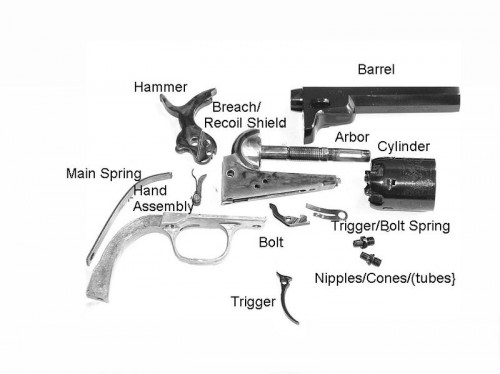

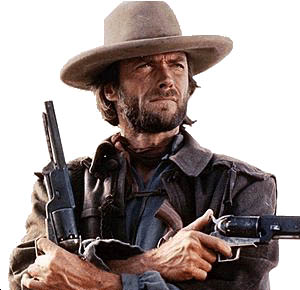
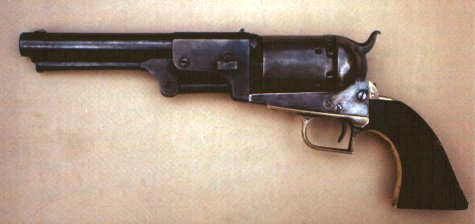
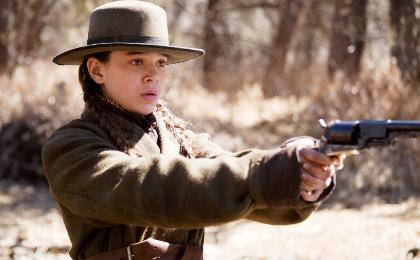

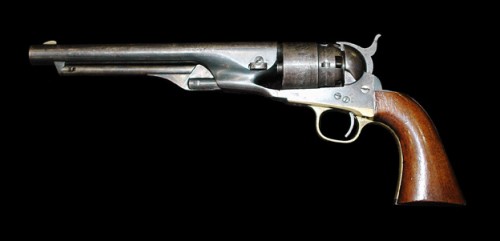

Thanx Mope, Jesse.
http://www.youtube.com/watch?v=OuP6rh4THQ4
I found a good video about loading sequences of the percussion revolvers.
Hehe the love for the colt is bigger than before :). Great work SAPE!
Great and very informative post, Sape!
Those guns are so big! I have some associations with dinosaurs, who had to become smaller and more effective, or simply got extinct.
Not extinct, evolved into birds 🙂 You got it.
Good work, Sape. Well documented and illustrated also with some of my favourite western movies. So many Colts, such a long page. Thank you.
Thanx Biondo. 🙂
Nice work Sape! Accurate information.
I have a question.
I read that the Colt Dragon revolver during the American Civil War made of bronze because the southerns have bad matrial conditions. It is true or just a legend?
At first I think it is true, because somewhere I read it too. I made some research, but I can’t find anything about it. Probably it is a legend.
Perhaps you’re thinking of the Confederate copies of the 1851 Navy made at Griswoldville. They were made with brass frames because the south was running out of materials for manufacturing. Some of them even (I’ve heard) have a red orange tint to the frame because they added copper when they were running short on everything else. Apparently they were pretty expensive (about $40 as compared to the Colt which was about $15). I looked this up after watching the first episode of Hell on Wheels. A major plot point is that the protagonist is known to be carrying a Griswold, which is easy to pick out because of the yellow frame.